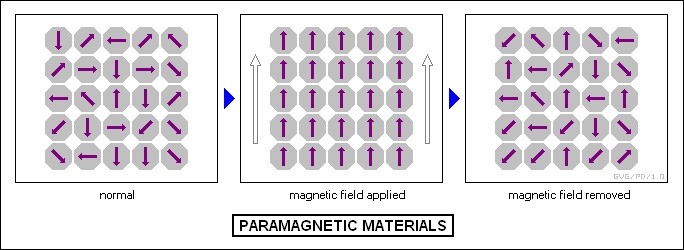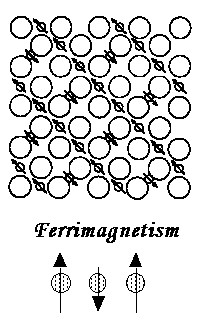Magnetic Properties of Materials
Table of Content |
Magnetic Properties of Materials
Magnetic Field: The magnetic field is an imaginary line of force around a magnet which enables other ferromagnetic materials to get repelled or attracted towards it.The magnetic field lines are formed due to various reasons like orbital movement of electrons, current flowing in a conductor etc.
Fig: Field Lines around a bar magnet
Properties of Magnetic field Lines
-
The Magnetic field lines by convention enter through the south pole and comes out of the north pole.
-
The magnetic field lines are strong near the poles of the magnet.
-
There is no chance of magnetic field lines intersecting with other.
-
More the closeness of the magnetic field lines, more is the strength of the magnet.
Magnetic Field Strength
Let us consider that a current carrying coil has produced a magnetic field H as shown in the diagram below:
Then the value of H is given by,
H = nI/L(A/m)
Where n is the number of turns in solenoid and l is the length of the cylinder.
Magnetic Flux Density(B)
When a substance is subjected to the magnetic field H, then the density of magnetic field lines that pass through the substance per square meter is known as Magnetic Flux Density. It is given by
B = μ X H (Tesla or weber /m2)
Where μ is called the Permeability and is defined as the degree to which a substance gets magnetized.The value of permeability in vacuum is given by
m = 4px 10-7(H/m)
Magnetic Moments
Motion of electrons in atoms gives rise to the phenomenon called magnetism. Basically two types of motions are associated with the electrons:
-
Motion of electrons in an orbit within the nucleus.
-
Spin of electrons around its axis
The spin and orbital moments imparts magnetic moment on each electron, forcing them to behave as tiny magnets.
The rotational force experienced by a magnet when placed in a magnetic field perpendicular to its magnetic axis is defined as the Magnetic Moment of a Magnet.
Classification of Magnets
Depending on the above explained properties of magnets, magnets can be classified as:
Diamagnetic Substance
Diamagnetic Substances are repelled by magnets due to the fact that they produce negative magnetization. The net magnetic moment is zero in diamagnetic substancebecause when an external field is applied to a diamagnetic substance then the magnetic moment of electrons is aligned to the opposite direction of the applied field. Every element in the periodic table possess the property of diamagnetism, but few elements like Cu, Al2O3, Si, Zn have stronger diamagnetic property.

Fig: Alignment of electrons opposite to magnetic field (H)
Paramagnetic Substance
In Paramagnetic material, there exists a little magnetic moment since the net magnetic moment is not cancelled outcompletely. The magnetic moments in paramagnetic material are randomly aligned and when they are subjected to an external magnetic field, these magnetic moments align themselves in the direction of the applied magnetic field H. Example of paramagnetic materials include Al, Cr, Mo,Ti,Zr.
Ferromagnetic Substance
Unlike diamagnets or paramagnets, those materials which tend to remain magnetized even when the magnetic field is removed exhibits ferromagnetism. This phenomenon is also known as Hysteresis and the plot between variations of magnetism with magnetic field is called Hysteresis Loop. However at one point or temperature the ferromagnetic materials tend to lose its magnetic properties. This temperature or point is known as Curie point or Curie Temperature.
Fig: The hysteresis loop
Ferri-Magnetic Substance
The basic difference between a ferromagnetic material and ferri-magnetic material is that some magnetic domains in ferri-magnetic material points in the same direction while some point in the opposite direction. While in case of ferromagnetic material all the magnetic domains point in the same direction.
Anti-Ferromagnetic Substance
In Anti-Ferromagnetic material, the magnetic moments of atoms or molecules usually related to the spin of the electrons, align in a regular pattern with neighbouring spins in opposite directions.MnO is an example of anti-ferromagnetism
Classification of elements in periodic table based on Magnetic Properties
Frequently Asked Questions (FAQs)
Q1. What is a magnetic material?
Sol. A magnetic material is a material which under the influence of its magnetic field can attract or repel other substances. The action of attracting or repelling a substance depend on the arrangement of electrons know as Magnetic Moment in the substance when brought under the influence of external magnetic field.
Q2. What are the properties of Magnet?
Sol. The properties of magnet are:
-
The north pole of one magnet is always attracted to the south pole of other magnet and vice-versa.
-
The magnet possess its own magnetic field lines due to various factors like flowing of current, orbital spin of electron, magnetic moment etc
-
The behaviour of a magnet is always studied with respect to the earth’s magnetic field.
Q3. What is meant by paramagnetic material?
Sol. A paramagnetic material is a substance which has little magnetic susceptibility. The net magnetic moment in paramagnetic substance is not cancelled out completely and hence they have very little magnetic strength. Example of paramagnetic materials include Al, Cr, Mo, Ti, Zr.
Watch this Video for more reference
More Readings







